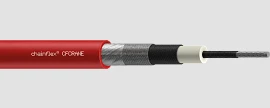The igus Mobile Shore Power Outlet (iMSPO) is the first mobile "socket" that can be used to connect ships at any point along the quay over a length of up to 400m. Container Terminal Hamburg (CTH) relies on three of these systems, which move along the quay on travels of 300, 150 and 110m.
The modular and configurable systems can be frequently found in container, cruise, RoRo and omni terminals. At the CTH, an iMSPO on a specially manufactured steel structure uses the free space above the terminal. The system was developed specifically for limited space above the flood wall and where free access is required for the emergency exit on the quay. The elevated position for the power supply and the moving parts of the trolley with the socket box (socket box trolley) always ensure sufficient distance from the ground and from people working there. In addition, the design requires no consideration of fenders and ensures smooth operation above critical areas of the terminal.
Rail elements run through the steel structure of the iMSPO, in which the mobile trolley with the socket box is installed. A roller energy chain designed for long travels and heavy loads moves within the rail system and ensures the safe and reliable guidance of the power or motor cables along the quay, such as the chainflex motor cables CFCRANE. An E4.56 energy chain also allows for cable guidance on the last part towards the panel while chainfix strain relief have been attached to the cables for a longer service life. Optional Sensor technology monitors the condition of chains and cables.
As soon as a ship has moored at the CTH, the iMSPO is moved to the mounting point. The protective cover of the socket box swings open, the ship's cables are connected, the protective cover is closed and locked for safe operation. All processes can be operated via a single control unit. The iMSPO has also been tested on the basis of IEC/IEEE 80005-1, a safety standard for high-voltage shore connection systems.
A ship can be connected to shore power in less than 15 minutes, with no more than two people being required on the shore side. All in all, this gives the Port of Hamburg full flexibility while reducing its operating, installation and maintenance costs.










